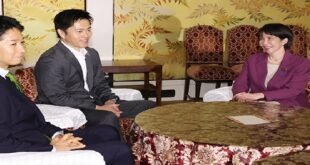22-07-2023
LONDON: In the early 1980s when Amandip Sidhu was growing up in Harrow, a suburb on the fringe of northwest London, his South Asian family was one of only a handful of non-white households in the area. Having spent some of his childhood in East Africa, where his father was a civil servant, Amandip and his family keenly felt the racist macroaggressions that were common across the United Kingdom at the time.
 This early experience of prejudice profoundly changed his brother Jagdip, who was five and a half years older than him. Jagdip decided that the best way to beat discrimination was to prove that he was better than his peers. “He was very much the golden boy, and everyone loved him,” Amandip says.
This early experience of prejudice profoundly changed his brother Jagdip, who was five and a half years older than him. Jagdip decided that the best way to beat discrimination was to prove that he was better than his peers. “He was very much the golden boy, and everyone loved him,” Amandip says.
After leaving secondary school with top grades, Jagdip went on to tertiary college, which was at the time a prerequisite for entrance into university. Just to outdo himself, he made a request to the college to be allowed to take four subjects instead of the maximum three for his exams. The request was rejected, but Jagdip refused to be deterred. He bought himself a textbook and taught himself physics, eventually scoring straight As.
Amandip found it tough being continually compared with his accomplished sibling. “I’m not academically gifted, and my dad would have a go at me about it sometimes,” he says. “And my brother would step in and say, ‘Look, just leave him alone.’ He was the only person my dad would listen to.”
 Jagdip sailed through medical school, his scholastic record peppered with awards. Then he started work at Ealing Hospital in West London. Amandip recalls how his brother bought a new pair of shoes and, a short time after he started work, showed him his feet. They were bleeding and covered in blisters. Amandip was shocked, but Jagdip was pleased. He was so busy at the hospital that he had been rushing around for 10 miles (16km) a day.
Jagdip sailed through medical school, his scholastic record peppered with awards. Then he started work at Ealing Hospital in West London. Amandip recalls how his brother bought a new pair of shoes and, a short time after he started work, showed him his feet. They were bleeding and covered in blisters. Amandip was shocked, but Jagdip was pleased. He was so busy at the hospital that he had been rushing around for 10 miles (16km) a day.
“He felt it was a badge of honor, the fact that his shoes were worn out, that he didn’t have anything to eat or drink or even go to the toilet,” Amandip explains. It was almost as if these were accepted symbols of the dedication needed to be considered a good doctor by the profession and health systems. (Int’l Monitoring Desk)
 Pressmediaofindia
Pressmediaofindia




